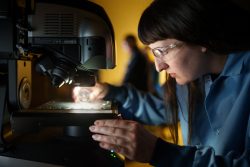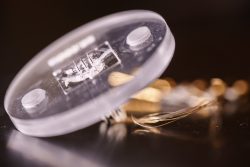
Since the discovery of penicillin in 1928, bacteria have evolved numerous ways to evade or outright ignore the effects of antibiotics. Thankfully, healthcare providers have an arsenal of infrequently used antibiotics that are still effective against otherwise resistant strains of bacteria.

Sandia National Laboratories postdoctoral fellow Alex Downs places a wearable puck with microneedles under a microscope. Sandia researchers have combined earlier work on minimally invasive microneedles with nanoscale sensors to create a wearable sensor patch capable of continuously monitoring the levels of a 'last line of defense' antibiotic. (Photo by Craig Fritz) Click on the thumbnail for a high-resolution image.
Researchers at Sandia National Laboratories have combined earlier work on painless microneedles with nanoscale sensors to create a wearable sensor patch capable of continuously monitoring the levels of one of these antibiotics.
The specific antibiotic they're tracking is vancomycin, which is used as a last line of defense to treat severe bacterial infections, said Alex Downs, a Jill Hruby Fellow and project lead. Continuous monitoring is crucial for vancomycin because there is a narrow range within which it effectively kills bacteria without harming the patient, she added.
"This is a great application because it requires tight control," said Philip Miller, a Sandia biomedical engineer who advised on the project. "In a clinical setting, how that would happen is a doctor would check on the patient on an hourly basis and request a single time-point blood measurement of vancomycin. Someone would come to draw blood, send it to the clinic and get an answer back at some later time. Our system is one way to address that delay."
The researchers shared how to make these sensors and the results of their tests in a paper recently published in the scientific journal Biosensors and Bioelectronics.
Making electrochemical microneedle sensors
The sensor system starts with a commercially available microneedle, commonly used in insulin pens. Adam Bolotsky, a Sandia materials scientist, takes a polymer-coated gold wire about ¼ the thickness of a human hair and trims one end at an angle. He then carefully inserts the gold wire into the needle, solders it to a connector and ensures it is electrically insulated. The researchers also construct reference and counter electrodes in a similar manner, using coated silver and platinum wires inside commercial microneedles, respectively.
These needles are then inserted into a plastic patch, the size of a silver dollar, designed by Sandia technologists Bryan Weaver and Haley Bennett. This patch includes room for nine microneedles but can be adjusted for any number desired, Downs said. On the exposed, diagonal surface of each gold wire, the researchers chemically attach the nanoscale sensors.

A microneedle-based sensor puck designed by Sandia National Laboratories researchers to continuously monitor the levels of a 'last line of defense' antibiotic with less pain than a blood draw. (Photo by Craig Fritz) Click on the thumbnail for a high-resolution image.
The sensors, called aptamers, are strands of DNA with a surface linker on one end and an electrically sensitive chemical on the other. Downs explained that when the DNA binds to the antibiotic vancomycin, it changes its shape, bringing the electrically sensitive chemical closer to the gold surface. This movement increases the current detected by the sensor system. When the concentration of vancomycin decreases, some of the DNA returns to its original shape, which is also detected electrically.
"This reversibility is useful for things like real-time measurements," Downs said. "If you want to see the concentration of a certain chemical present in the skin or in the blood at any given time, then being able to measure increases and decreases is really important."
Downs worked with the aptamer sensor during her doctoral research and brought the knowledge with her to Sandia, where she worked to combine it with Sandia's expertise with microneedles that can provide doctors with similar information of a blood draw with less pain.
"I merged my knowledge of aptamer-based sensing and real-time monitoring with the technology that Ronen Polsky and Phil Miller had developed at Sandia," Downs said. "By integrating these two tools, we substantially miniaturized the sensing system and verified that it worked in a microneedle."
Putting the needles to the test (and next steps)
After constructing the microneedle sensors, the team tested whether a microneedle sensor could detect vancomycin in a saline solution mimicking the conditions inside the body, Downs said. Once successful, they tested the entire system, complete with reference and counter electrodes, in a much more complex solution: undiluted cow blood. The system was still able to detect vancomycin.
Then, to test if the microneedles and aptamers would work after being inserted into the skin, the researchers inserted the patch into pig skin several times, monitored the electronic signal from the patch while it was in the skin, and tested its ability to detect vancomycin.
"It was very uncertain if this was going to maintain a signal when you put it in the skin," Downs said. "Each microneedle is its own individual sensing electrode. If the sensors are not forming good electrical contact, then this really wouldn't work. That was the biggest uncertainty and something we had never tested at Sandia."
Since successfully testing the sensor patch system, the next step is partnering with another research group to test them in humans or other animals, Downs and Miller said.
"The next big technical hurdle is proving that it works in the body for an extended amount of time," Miller said.
Looking ahead, a similar system with different DNA aptamers could be used to monitor cytokines, small proteins used to convey messages within the body, as well as other proteins or smaller molecules that change significantly during infections. These systems could help doctors diagnose what illness a patient has more rapidly or even assist with triage during emergency situations.
Downs has also been studying what things in the blood and skin could "clog" up the sensors and reduce their accuracy over time. She, along with summer intern Amelia Staats, found that fibrinogen, a protein involved in blood clotting, is a key culprit in signal interference. The researchers plan to publish these findings in an upcoming paper.
"This system could be used really anywhere where you're having large chemical changes in the body, where you want to measure those changes over time to better understand what's happening in the body," Downs said.
Sandia National Laboratories is a multimission laboratory operated by National Technology and Engineering Solutions of Sandia LLC, a wholly owned subsidiary of Honeywell International Inc., for the U.S. Department of Energy's National Nuclear Security Administration. Sandia Labs has major research and development responsibilities in nuclear deterrence, global security, defense, energy technologies and economic competitiveness, with main facilities in Albuquerque, New Mexico, and Livermore, California.






